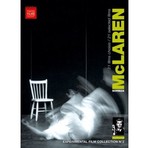Figure 1, (2009), Begone Dull Care
Norman Mclaren created animations that responded to the soundtrack with a range of tempos. In the case of Begone Dull Care, the piece responds to jazz so there is a range of bright colours and shapes to mimic the speed the instruments are played. "Begone were created after the music had been produced, designed to give images to music." (North, 2010) the evidence identifies that Mclaren's abstract style of colour and shape are vision responses to the actual music to capture the rhythm emotion of the piece. Mclaren's technique was quite basic to give his visual imagery across as demonstrated in Le Merle and Lines Horizontal because the viewer can engage the importance of the shapes in connection to the music. " [He would] methodically go through the absolutely basic techniques available to the animator to create the illusion of motion, demonstrating the different effects - and crucially, the different emotional effects - to be had from varying the tempo of movement." (Hobbs, 2011) Mclaren wanted his animations to give the impression of motion through the speed of tempo so slower sequences would appear more relaxing to the fast paced sequences.
Figure 2, (2011), Lines Horizontal
Figure 3, (2008), Pas de Deux
In some of the animations, Mclaren attempts to capture the beauty of movement and rhythm as displayed in Pas de Deux with white silhouetted figures moving gracefully as they create the dance movements and shapes. "Watching the collection is a tremendously varied and engaging experience, from the abstract and playful colour antics and jazz score of Boogie-Doodle (1940) to the 'live action' story of a man attempting to sit in a reluctant chair in A Chairy Tale (1957) to Mclaren's 'Line' films (1960 - 62) composed of moving lines that oscillate back and forth across the screen in rhythmic patterns." (Cummings, 2004) The evidence shows how the range of techniques and animations inspire to capture the rhythm of patterns by concentrating on how the expressions of movement and colour. In the case of Pas de Deux the white silhouettes are moving on a black background so that they are defined and the viewer can see what is happening clearly.
Figure 4, (2007), Le Merle
Illustrations
Figure 1, (2009), Begone Dull Care, @ http://drnorth.wordpress.com/2009/06/25/begone-dull-care-norman-mclaren-randomised/, Accessed on: 26th June 2009
Figure 2, (2011), Lines Horizontal, @ http://www.dailymotion.com/video/x19vai_lines-horizontal-norman-mclaren-196_shortfilms, Accessed on: 2005
Figure 3, (2008), Pas de Deux, @ http://www.johncoulthart.com/feuilleton/2008/04/12/norman-mclaren/, Accessed on 12th April 2008
Figure 4, (2007), Le Merle, @ http://www.chelseaspace.org/archive/azumi-pr.html, Accessed on: 16th June 2007
Bibliography
Cummings Doug, 2004, filmjourney.org, @ http://www.filmjourney.org/2004/03/07/norman-mclaren/, Accessed on: 7th March 2004
Hobbs Graeme, (2011), Every Film is a kind of dance: The Art of Norman Mclaren, @ http://www.moviemail-online.co.uk/scripts/article.pl?articleID=276, Accessed on: 1996
North Dan, (2010), The Significance of Sound in Norman Mclaren's Films, @ http://drnorth.wordpress.com/2010/12/04/the-significance-of-sound-in-norman-mclaren%E2%80%99s-films/, Accessed on: 4th December 2010







No comments:
Post a Comment